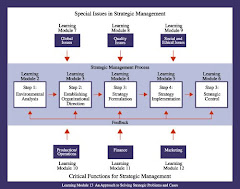Wednesday, February 25, 2009
Lessons Learned
Hi Everyone,
I was hoping we could share some "lessons learned" from our experience with MikesBikes. Our team learned a lot about risk and reward (especially in regards to product development). It was also challenging to keep our strategies aligned with our company mission - in the midst of an constantly changing environment.
Thoughts?
I was hoping we could share some "lessons learned" from our experience with MikesBikes. Our team learned a lot about risk and reward (especially in regards to product development). It was also challenging to keep our strategies aligned with our company mission - in the midst of an constantly changing environment.
Thoughts?
Wednesday, February 18, 2009
Strategic Control vs. Organizational Control
As defined in module 6, strategic control is a special type of organizational control that focuses on monitoring and evaluating the strategic management process to make sure that it functions properly. Organizational control is monitoring the activities and includes: measuring performance, comparing measured performance to standards, and taking corrective action. Is the main difference that strategic control focuses on providing feeback for whether steps are appropriate, compatible, and functioning appropriately while organizational control is the process of monitoring and improving the activities within the organization?
Thursday, February 12, 2009
Controling What Matters
Employees behave in ways that mirror what management monitors, so it is critical to align organizational controls and measurements to what you want employees to focus on. I worked for a company that tracked (and gave bonuses for) sales performance. While corporate “focused” on payroll, it was not originally part of the bonus structure so payroll was ignored. When we started receiving labor reports and a bonus linked to controlled payroll, our behaviors changed quickly.
Wednesday, February 11, 2009
Simulation vs Reality
What I have learned from using Mikes Bikes is that the offline mode simulation is good for practice but it shouldn't be heavily relied on for making our real life decisions in the online mode. It is impossible to predict human behavior and emotions with a simulation. Our decisions should be based on business cirucmstances to maximize our learning.
The Doom Loop
The book "Good to Great" talks about the Doom Loop. The Doom Loop starts at the juncture of environmental analysis and strategy formulation, where the company does not choose an appropriate strategy to align the company with its environment. It also comes from a failure at the juncture of strategy implementation and formulation, where a company abandons its strategy before seeing the results of longterm decisions and chooses a new strategy as a reaction instead of as the result of careful environmental analysis.
What do you think, where does the Doom Loop starts for most failed companies?
What do you think, where does the Doom Loop starts for most failed companies?
Wednesday, February 4, 2009
An Example...Imitating vs. Innovating
In module 4, the example of how Japanese electronic companies were quite successful in the 1970s and 1980s in copying American technology is mentioned. By avoiding many R&D costs, the Japanese companies improved their competitive position significantly. In my Management of Innovation class we read an article, Not made in Japan, that discusses how Japan is now having issues with sustaining in the digital age. The article says that this is due mostly to the country's corporate culture as the Japanese market is disinclined to creativity and the many barriers between company divisions. To me this shows that one can only get so far with imitating and a strong long term company strategy is vital.
Imitation vs. Innovation
It is easier to imitate new products, innovative production methods, and marketing, but is this sustainable? Will it give you advantage over time? I think that the key to sustainability is innovation not imitation. Innovation can come from getting access to key resources or customers and achieving size advantage in market. This is where strategy formulation is key to overcoming the challenge of sustainability.
Subscribe to:
Comments (Atom)
